In recent years I’ve had the pleasure of working with clients on some corporate video projects. It’s been an interesting and fun change from the IT world where I’ve spent most of my career, and as an outsider to the industry looking in, I’ve found it a fascinating learning experience. This week I plan on peppering different sites I’m active on with articles about my thoughts on corporate video planning, so keep your eyes peeled (hint: download my free ebook to get notified of where related articles pop up).
The fundamental problem with corporate video is, these video projects often begin without a script. Go down to any bookstore and look for books on the business of video production. By and large what you’ll find is, documented processes expect a script to be in place before work begins on deconstructing that script into a cohesive plan. If you’re making a video as a commercial venture, it’s certainly valid to say, “find a script that’s completed and buy the rights to it, at which point we’ll begin work”.Initial work will be to spend time breaking out the individual components of the script, first figuring out what needs to be filmed, and what needs to be performed in post-production. The balance of the planning will be to work out the logistics of executing those tasks. With all of the details in hand, a budget will emerge, which can then be peddled to investors to get the required funding (or amendments made to the plan to fit within whatever funding arrangements can be procured).
But the script already exists.
Corporate video, on the other hand, often doesn’t have that luxury. The sponsor of a corporate video project is often starting out from scratch, generally with little more than an idea on what the video should be about. Without a script, it’s very, very difficult to say how much a video project will cost, especially with all of the variables associated with a video production. But for a sponsor to get approval for a video project to go ahead, he or she must usually submit a budget request to their management.
So which comes first, the plan or the budget?
We face this problem on IT projects all the time. Conventional wisdom is to develop a high level budget first, set an accuracy threshold, and submit a new, more accurate budget after a detailed design phase is complete.
There’s an important difference between IT projects and video projects, however. By and large, the costs associated with an IT project are labour-based. That is, the cost of the project is peoples’ time. Any variation in accuracy really comes down to how much time you believe each person must work to get the job done.
In addition to labour-based expenses, a video project has wildly more variation in terms of what the project could cost. For example, if you decide on a high level budget of $50,000 at the onset of the project, you can completely kiss that goodbye if you opt to bring in Julia Roberts to narrate at her Hollywood rates.
The following graphic shows just ten possible variables associated with a video project, that could radically alter its cost, depending on where in the continua choices get made.
A finished script would inform all of the above variables, but you don’t have one yet. That’s all the more reason to plan out the project in baby steps. What I’ve been recommending to my clients who are starting video projects is a structure as follows:
1) Develop high level objectives for the project, and identify where the video fits against other initiatives at the organization. That should inform…
2) …the key points that need to be communicated in the video. They should inform…
3) …whether or not specific visualizations or sounds are important (especially if the intent of the video is to educate). If they are, work out the form those ideas should take (at a high level). Those should inform…
4) …the order of delivery for each point. Place them in a sequence that makes sense. That should inform…
5) …a narrative brief. Taking the foregoing elements, weave them into a high level concept, no more than a paragraph, that explains the story of how each element hangs together. That should inform…
6) …the full script.
Each point above should require approval from the project sponsor, and any subject matter experts who need to be involved from a content standpoint, before work moves forward. Also, it’s wise to have the director and someone from post production on hand for each of those steps to validate whether or not a) the work is possible and b) the work can be contained within the high level budget. If the script calls for crazy special effects that will send the budget to the moon, you’ll want someone on hand to call that out early, rather than waiting until later to find out the project can’t afford it.
Regarding budgeting, I’ve been recommending a formal budget checkpoint at the very start of the project, after the script is complete, and before production starts:
- The first budget checkpoint is a SWAG (silly, wild-assed guess) that comes down to negotiations between the project sponsor and the producer–this is to get approval to begin the project, and to give everyone involved a sense of how much money they have to work with.
- The second budget checkpoint it to confirm, based on a finished script, that the work can be done more or less within the allotted budget. This estimate should be much more accurate than the first. It also gives everyone a chance to revise the script to find different alternatives if the cost looks like it will be too high.
- The third budget checkpoint is to confirm, after all the planning is complete, exactly what costs the project will incur in production and post production, to deliver the finished video. This estimate should be very accurate, although reasonable allowances should be made for contingencies.
Remember that rework on any project can seriously damage a budget, but rework on a video project can be its death knell. If a portion of video needs to be reshot for any reason, it’s not just a question of billing more of people’s time. Locations have to be booked and set up, equipment has to be procured and brought in, there needs to be arrangements for food and electricity…the list goes on. That means, as much as possible, all decisions regarding video content should be made and planned out before a single camera is lifted.
I’ll be continuing this theme in articles in a few online magazines this week. I’m fascinated with the video production process, so if you’ve got your own thoughts on the subject, by all means chime in below! I’ll be publishing the addresses of related articles in an upcoming newsletter, so be sure to check that out too.
Related articles by Zemanta
- Deconstructing Lady Gaga’s / Beyonce’s “Telephone” (edge.papercutpm.com)
- Want a project to fail? Behave like this. (edge.papercutpm.com)
- The Importance of Precision (edge.papercutpm.com)
- Mentor Room Recommendation: slide:ology (edge.papercutpm.com)
- Constructing a Video Commercial Contract Form (brighthub.com)
- Creating a Film Budget Form (brighthub.com)
- Jump! Reel (slideshare.net)



